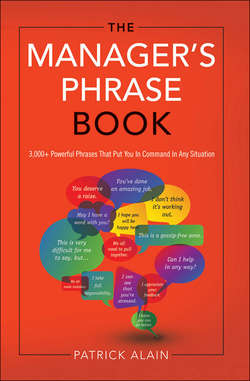Читать книгу The Manager's Phrase Book: 3000+ Powerful Phrases That Put You In Command In Any Situation - Alain Patrick - Страница 3
На сайте Литреса книга снята с продажи.
How to Use This Book
ОглавлениеThis book was designed with flexibility in mind. You can read it all the way through to get a general overview, or you can work on one particular situation or aspect of communication that you find the most challenging or relevant. For example, you may feel very comfortable talking to an employee about a personal problem, but you may not feel as relaxed when doling out criticism. Use the in-depth Index at the back to help you find the topic that is most applicable to your situation.
Read all the sample phrases and make a point to familiarize yourself with the ones that seem the most natural or comfortable for you. Then practice them until they flow naturally from your mouth. When the time comes you’ll have no trouble summoning them and using them with confidence and aplomb. And because everyone says things in a slightly different way, there’s a bit of space in the margins where you can add your own favorite catch phrases. The right words are not enough, however. Remember that tone, body language, and timing (context) are all important in conveying meaning and in how your statements are perceived by others. Thus, a humorous phrase that would be effective and appropriate in one setting could be construed as hostile and inappropriate in another, depending on how, when, and to whom it is said. Use good judgment and let context be your guide. This is particularly important when you are considering using humor or sarcasm to make a point. Humor can sometimes come across as flip or dismissive, and sarcasm is definitely one of the quickest ways to make someone feel inept. Not everyone will appreciate your style of delivery, so nuance is always required.
Conciliatory
The indicator accompanying each situation will help you anchor each “order of magnitude” in your mind, which will serve as a valuable mnemonic device down the road. For example, in the sample to the left, the continuum indicator goes from Conciliatory to Argumentative. All of the phrases in this book are presented on a similar scale. In this example, if you wanted to build bridges and/or smooth things over, you would learn and use the phrases toward the top. If you wanted to eliminate the niceties and cut to the chase – and maybe even wield your words as you would a weapon – you would use the phrases toward the bottom.
Argumentative
Finally, I thought it important to note that I am embracing the English language as most people understand and use it in America today; thus, the reader will find colloquialisms and some slang. Obviously, the vagaries of expression will be much different in, say, Canada or Australia, as they will be even in different parts of the States. Ultimately, the English language, like all languages, is a living thing; it is in constant flux. Therefore I’m prepared for the fact that the material in this book will need updating from time to time, as the way we express ourselves inevitably evolves. Please visit my Website, www.patrickalain.com, for the most up-to-date information to add to your linguistic arsenal. I also welcome your comments on and criticisms of this work to help me in that process.
